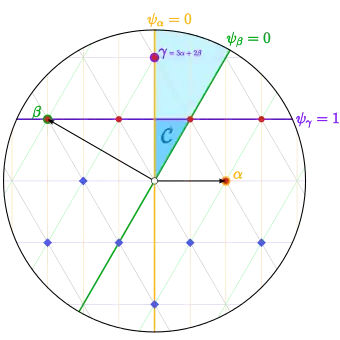Affine root system
In mathematics, an affine root system is a root system of affine-linear functions on a Euclidean space. They are used in the classification of affine Lie algebras and superalgebras, and semisimple p-adic algebraic groups, and correspond to families of Macdonald polynomials. The reduced affine root systems were used by Kac and Moody in their work on Kac–Moody algebras. Possibly non-reduced affine root systems were introduced and classified by Macdonald (1972) and Bruhat & Tits (1972) (except that both these papers accidentally omitted the Dynkin diagram ![]()
![]()
![]()
![]()
![]() ).
).

Definition
Let E be an affine space and V the vector space of its translations. Recall that V acts faithfully and transitively on E. In particular, if , then it is well defined an element in V denoted as which is the only element w such that .
Now suppose we have a scalar product on V. This defines a metric on E as .
Consider the vector space F of affine-linear functions . Having fixed a , every element in F can be written as with a linear function on V that doesn't depend on the choice of .
Now the dual of V can be identified with V thanks to the chosen scalar product and we can define a product on F as . Set and for any and respectively. The identification let us define a reflection over E in the following way:
By transposition acts also on F as
An affine root system is a subset such that:
- S spans F and its elements are non-constant.
- for every .
- for every .
The elements of S are called affine roots. Denote with the group generated by the with . We also ask
- as a discrete group acts properly on E.
This means that for any two compacts the elements of such that are a finite number.
Classification
The affine roots systems A1 = B1 = B∨
1 = C1 = C∨
1 are the same, as are the pairs B2 = C2, B∨
2 = C∨
2, and A3 = D3
The number of orbits given in the table is the number of orbits of simple roots under the Weyl group. In the Dynkin diagrams, the non-reduced simple roots α (with 2α a root) are colored green. The first Dynkin diagram in a series sometimes does not follow the same rule as the others.
| Affine root system | Number of orbits | Dynkin diagram |
|---|---|---|
| An (n ≥ 1) | 2 if n=1, 1 if n≥2 | |
| Bn (n ≥ 3) | 2 | |
| B∨ n (n ≥ 3) | 2 | |
| Cn (n ≥ 2) | 3 | |
| C∨ n (n ≥ 2) | 3 | |
| BCn (n ≥ 1) | 2 if n=1, 3 if n ≥ 2 | |
| Dn (n ≥ 4) | 1 | |
| E6 | 1 | |
| E7 | 1 | |
| E8 | 1 | |
| F4 | 2 | |
| F∨ 4 | 2 | |
| G2 | 2 | |
| G∨ 2 | 2 | |
| (BCn, Cn) (n ≥ 1) | 3 if n=1, 4 if n≥2 | |
| (C∨ n, BCn) (n ≥ 1) | 3 if n=1, 4 if n≥2 | |
| (Bn, B∨ n) (n ≥ 2) | 4 if n=2, 3 if n≥3 | |
| (C∨ n, Cn) (n ≥ 1) | 4 if n=1, 5 if n≥2 |
Irreducible affine root systems by rank
- Rank 1: A1, BC1, (BC1, C1), (C∨
1, BC1), (C∨
1, C1). - Rank 2: A2, C2, C∨
2, BC2, (BC2, C2), (C∨
2, BC2), (B2, B∨
2), (C∨
2, C2), G2, G∨
2. - Rank 3: A3, B3, B∨
3, C3, C∨
3, BC3, (BC3, C3), (C∨
3, BC3), (B3, B∨
3), (C∨
3, C3). - Rank 4: A4, B4, B∨
4, C4, C∨
4, BC4, (BC4, C4), (C∨
4, BC4), (B4, B∨
4), (C∨
4, C4), D4, F4, F∨
4. - Rank 5: A5, B5, B∨
5, C5, C∨
5, BC5, (BC5, C5), (C∨
5, BC5), (B5, B∨
5), (C∨
5, C5), D5. - Rank 6: A6, B6, B∨
6, C6, C∨
6, BC6, (BC6, C6), (C∨
6, BC6), (B6, B∨
6), (C∨
6, C6), D6, E6, - Rank 7: A7, B7, B∨
7, C7, C∨
7, BC7, (BC7, C7), (C∨
7, BC7), (B7, B∨
7), (C∨
7, C7), D7, E7, - Rank 8: A8, B8, B∨
8, C8, C∨
8, BC8, (BC8, C8), (C∨
8, BC8), (B8, B∨
8), (C∨
8, C8), D8, E8, - Rank n (n>8): An, Bn, B∨
n, Cn, C∨
n, BCn, (BCn, Cn), (C∨
n, BCn), (Bn, B∨
n), (C∨
n, Cn), Dn.
Applications
- Macdonald (1972) showed that the affine root systems index Macdonald identities
- Bruhat & Tits (1972) used affine root systems to study p-adic algebraic groups.
- Reduced affine root systems classify affine Kac–Moody algebras, while the non-reduced affine root systems correspond to affine Lie superalgebras.
- Macdonald (2003) showed that affine roots systems index families of Macdonald polynomials.
References
- Bruhat, F.; Tits, Jacques (1972), "Groupes réductifs sur un corps local", Publications Mathématiques de l'IHÉS, 41: 5–251, doi:10.1007/bf02715544, ISSN 1618-1913, MR 0327923, S2CID 125864274
- Macdonald, I. G. (1972), "Affine root systems and Dedekind's η-function", Inventiones Mathematicae, 15 (2): 91–143, Bibcode:1971InMat..15...91M, doi:10.1007/BF01418931, ISSN 0020-9910, MR 0357528, S2CID 122115111
- Macdonald, I. G. (2003), Affine Hecke algebras and orthogonal polynomials, Cambridge Tracts in Mathematics, vol. 157, Cambridge: Cambridge University Press, pp. x+175, ISBN 978-0-521-82472-9, MR 1976581